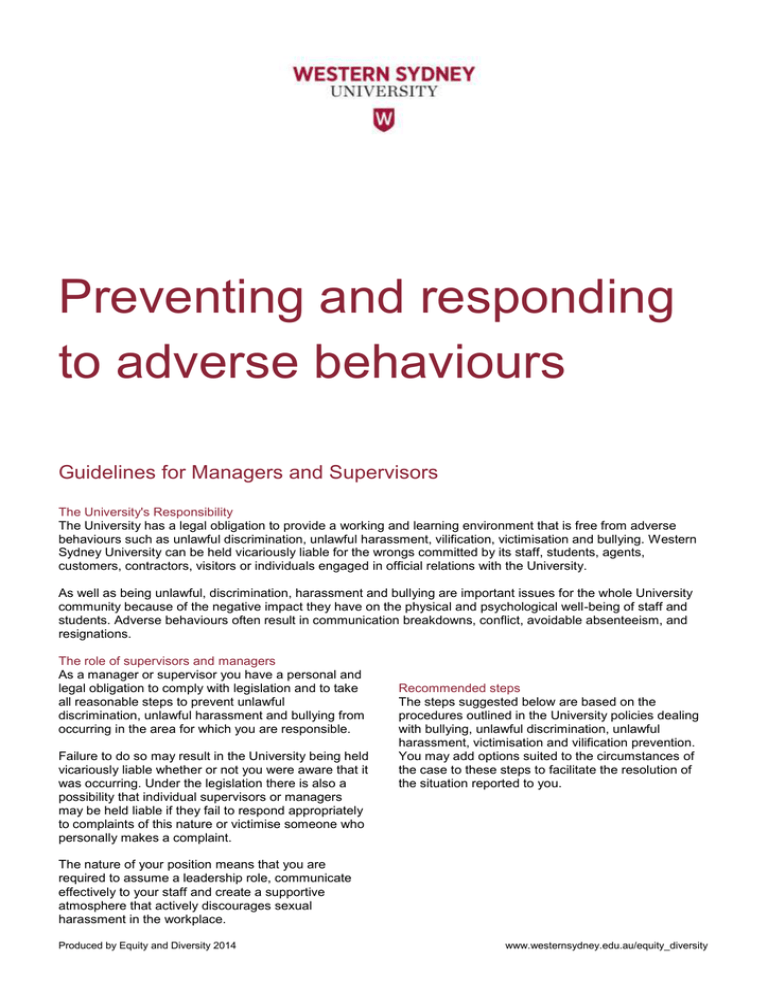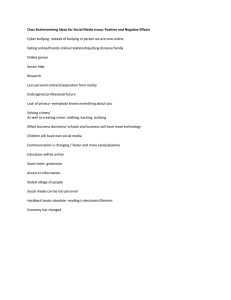Preventing and responding to adverse behaviours Guidelines for Managers and Supervisors
advertisement

Preventing and responding to adverse behaviours Guidelines for Managers and Supervisors The University's Responsibility The University has a legal obligation to provide a working and learning environment that is free from adverse behaviours such as unlawful discrimination, unlawful harassment, vilification, victimisation and bullying. Western Sydney University can be held vicariously liable for the wrongs committed by its staff, students, agents, customers, contractors, visitors or individuals engaged in official relations with the University. As well as being unlawful, discrimination, harassment and bullying are important issues for the whole University community because of the negative impact they have on the physical and psychological well-being of staff and students. Adverse behaviours often result in communication breakdowns, conflict, avoidable absenteeism, and resignations. The role of supervisors and managers As a manager or supervisor you have a personal and legal obligation to comply with legislation and to take all reasonable steps to prevent unlawful discrimination, unlawful harassment and bullying from occurring in the area for which you are responsible. Failure to do so may result in the University being held vicariously liable whether or not you were aware that it was occurring. Under the legislation there is also a possibility that individual supervisors or managers may be held liable if they fail to respond appropriately to complaints of this nature or victimise someone who personally makes a complaint. Recommended steps The steps suggested below are based on the procedures outlined in the University policies dealing with bullying, unlawful discrimination, unlawful harassment, victimisation and vilification prevention. You may add options suited to the circumstances of the case to these steps to facilitate the resolution of the situation reported to you. The nature of your position means that you are required to assume a leadership role, communicate effectively to your staff and create a supportive atmosphere that actively discourages sexual harassment in the workplace. Produced by Equity and Diversity 2014 www.westernsydney.edu.au/equity_diversity Step 1. Listen Actively listen to the report of bullying when someone makes a complaint of bullying to you. Listen to them without prejudice, that is, as far as possible set aside your ideas about them and the person they are complaining about. Ask questions to get a complete picture of the situation and to ascertain how the person making the complaint is being affected by the bullying. Make notes on what has been reported to you and keep them in a confidential file. Step 2. Provide information and advice Provide information about the options available to them to deal with the situation. For example: getting support and advice, talking to the bully if appropriate, doing some training, making a complaint, etc. If the person reporting the bullying is a staff member, remind them to complete an OHS Accident/Injury/Incident/Hazard Form. You should suggest they visit this website and read the Bullying Prevention Policy - provide them with a copy of the policy, guidelines, and relevant section(s) from this website. Step 3. Assess your role Once an allegation of bullying has been reported, you have a duty of care to respond to the situation. The response that you make depends on the circumstances of the case and the seriousness of the allegations. If the person reporting the bullying has asked you not to do anything about it and to maintain confidentiality, you need to explain that you have a duty to act and that you need to assess the situation and decide which action is most appropriate. In relation to confidentiality, you need to explain that you can only maintain confidentiality to the extent that it does not impede your duty of care towards them. Step 4. Assess the situation Consider the evidence provided to you, the particular circumstances of the case, and assess whether the behaviour reported to you falls within the definition of Produced by Equity and Diversity 2014 bullying. This is not a simple task and we strongly advise that you seek assistance from your Business Partner at Human Resources and Equity and Diversity if the complaint is against a staff member, or Policy and Governance if the complaint is against a student. Tip: In order to assess whether bullying is occurring you may: pay particular attention to the behaviour of the alleged bully, particularly in relation to the person making the complaint talk to the alleged bully and any witnesses make notes on the situation discuss the matter with an appropriate University staff member If you decide that the behaviour does not fall within the definition of bullying you still need to act to address the situation. It may be that the situation represents a breakdown in communication, unacceptable professional conduct or non-academic misconduct, unlawful behaviour such as discrimination, harassment, or vilification, or another adverse behaviour. Seek advice and support in addressing the situation because these areas of responsibility are complex and you have a legal duty to act appropriately. If the behaviour does fall within the definition of bullying, your actions need to be appropriate for the situation and follow the procedure in the University’s Bullying Policy. Here are some suggested actions: Raise the issue at staff meeting or class At your next staff meeting or class raise the issue of bullying or group communication and remind staff or students of the requirements for respect and inclusion under University policy. The aim of this is to send a message to all staff and students about the issue without specifically bringing it up with the alleged bully. Talk to the alleged bully Organise a meeting with the alleged bully somewhere that is private and otherwise appropriate - they may wish to bring a support person along. Sensitively tell the person of the behaviours that concern you and the effects that they are having. Allow them to explain their behaviours from their perspective. Explain that regardless of the reasons for their behaviour, such behaviour is not acceptable at Western Sydney University, is against University policy, and it should be stopped immediately. www.westernsydney.edu.au/equity_diversity Explain that regardless of whether they feel that they have been behaving in a bullying manner, that to continue behaving in that way may have serious consequences for them. Offer the alleged bully opportunities for personal or professional development to address the problematic behaviours. Explain to the person that you will follow the procedures in the University Bullying Prevention Policy. You should suggest they visit this website and read the Bullying Prevention Policy and Guidelines provide them with a copy of the policy, guidelines, and the relevant section(s) from this website. Meet with aggrieved person Two weeks after your first action, organise to meet with the person who reported the problem and ask them if the bullying has stopped. Recommend mediation If the bullying has not stopped, assess whether mediation is suitable and recommend to both parties that they participate in mediation to resolve the issue. It is important that the aggrieved person does not feel obliged to attend the mediation, especially if they are fearful. If the parties agree to participate and they are staff members contact your Business Partner at Human Resources for assistance. If the parties do not agree to mediation inform them of the next steps that you will take. Resolution Unit will investigate the alleged bullying that will occur when a formal internal complaint is made. Step 7. Report bullying to HR Business Partner Report bullying to your Business Partner at Human Resources - if the alleged bullying is by a staff member, although you may have previously spoken to HR about the issue, at this point you need to formally notify your Human Resources Business Partner of the situation and what you have done to address the issue. HR will provide you with support to deal with the situation and will ask you, after a two-week period, whether the bullying has stopped. If the bullying has not stopped, HR will investigate the matter by speaking to all relevant parties and making specific recommendations on how to resolve the matter. You need to implement the recommendations and report back to HR on the progress of the matter. Step 8. Advise to make formal internal complaint Advise aggrieved person to make formal internal complaint - if the bullying has not stopped after having taken all the above steps above, advise the aggrieved person to make a formal internal complaint about a serious matter with the Complaints Resolution Unit. Step 9. Provide support to both parties Provide support to both parties - you need to provide equal support to both parties who are going through the complaint resolution process despite your feelings about the situation. If the bullying is by a student contact Student Support Services. Step 5. Complete OHS form If the behaviour amounts to bullying you need to fill in an OHS Accident/Injury/Incident/Hazard Form outlining the problem and the steps you have taken to address the situation. Step 6. Report bullying to the Complaints Resolution Unit Report bullying to the Complaints Resolution Unit they will log your complaint on their database and case manage the matter, including following up on progress. This does not mean that the Complaints Produced by Equity and Diversity 2014 www.westernsydney.edu.au/equity_diversity




